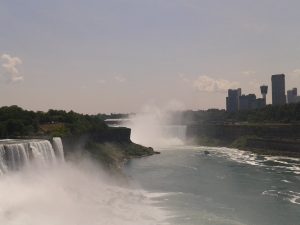H.Xie
Author: admin
NINE CRAZY FACTS ABOUT THAILAND, THE LAND OF SMILES
- The world’s biggest Chinatown is situated in Bangkok.
- Thailand is the only country in South East Asia that wasn’t colonized by a western power.
- The Thai greeting “sawatdee” Originated during the Second World War. Prior to that, the usual greeting was to ask people whether they had eaten yet.
- Bangkok currently holds the Guinness world record for having the longest name of a place. Bangkok is actually the short version. The city’s ceremonial name is “krung thep mahanakhon amon rattanakosin mahinthara yuthaya mahadilok phop noppharat ratchathani burirom udomratchainiwet mahasathan amon piman awatan sathit sakkathattiya witsanukam prasit”. Now I challenge you to say it……..backwards.
- According to the World Meteorological Organization, Bangkok is the hottest capital city in the world. It may not be the hottest city in the world every day, but it’s certainly consistent in keeping with its reputation.
- Thailand also holds a large number of Guinness world records, including those for the man with the longest hair, the biggest hamburger, biggest restaurant, largest ever aerobic workout, and also for the most linked skydivers.
- In Thailand, both Father’s Day and Mother’s Day are celebrated to commemorate the birthdays of Their Majesties the King and the Queen.
- It is called the “land of smiles,” because of its ever smiling, inviting, soft spoken, friendly, and hospitable residents.
- Red Bull, the famous energy drink, originates in Thailand and was originally called red gaur.
Student: Chabuskhan Hamdalee
无声的幸福
无声的幸福
除夕近了,街上也变得热闹起来,我走在冬日的市中心,看着身旁提着大包年货的人群,心中却觉不到一丝暖意。
大连的冬天,还是一样的的干燥寒冷,虽然是晴天,但阳光的一丝余温早已消散在凛冽的北风中,寒风打在人脸上,只觉如刀割般的痛,也正因如此吧,街上的人都一副行色匆匆的神色,低着头躲避着迎面的寒风。
这时,三个与众不同的面孔闯入了我的眼帘,眼前的这几张脸上少了其他人的几分匆忙,多的是幸福的笑容。走在中间的是一个年龄与我相仿的女孩,那张白皙的脸上洋溢着带着青春气息的喜悦微笑,如同出水芙蓉般让人只敢隔着一段距离细细欣赏,生怕玷污了这份纯洁无瑕的美丽。
这自然吸引了我的注意,我放慢了脚步,看着迎面走来的这被幸福包围着的三个人,不觉被眼前的一幕吃了一惊,走在女孩左边的中年妇女向女孩右边的男人打了几下手势,嘴动了动,却没有发出声,似乎是想接过男人手里沉甸甸的购物袋,那男人用同样的方式回答了中年妇女,把手中的购物袋由左手换到了右手上,还故作轻松的抖了几下,女孩的头从左转向右,然后用两只胳膊一左一右把那妇女和男人揽到自己身边,脸上又一次露出灿烂的笑,两边的妇女和男人相互对视了一下,也露出了会心的笑容。
我顿时明白过来这是生活在无声世界的一家人,女人想帮丈夫提购物袋,但被拒绝了,男人把购物袋换到了离妻子较远的右手上,抖两下是为了给妻子看袋子并不沉,想不让妻子担心,女孩自然从这最简单的爱的流露中感受到了幸福,把爸爸妈妈挽到一起,那对夫妇在看到孩子,自然倍感幸福甜蜜,相视而笑。
这是多么平常的生活,而这又是多么难得的幸福!一家人虽不能用声音进行交流,但他们能够用他们自己的方式沟通,他们一家人的心在一起,互相理解,为对方着想,其实,这就铸就了世间最伟大的感情——-爱,和世间最简单却又最难获取的东西——–幸福。
我的脚步不觉停了下来,看着这幸福的一家从我身旁经过,我的目光久久不能从那三个背影上移开,只是在寒冷的冬日里感受到了发自心底的温暖,那是棉衣、空调所不能带来的,这是幸福的传递,是无声幸福的传递!
站在寒风中,我似乎感受到了来自阳光的温暖,目送着三个背影远去,我知道,对于那三个背影的任何一个来说,身边的两个人加在一起,就是他们的整个世界。
张颖慧
Chinese Students’ Perception of Foreign Direct investment into China
Chinese Students’ Perception of Foreign Direct investment into China
by
C.Yu
Abstract
Foreign direct investment (FDI) has played a key role in the emergence of globalization and in the rapid rise of China as a major economy. Given the important role played by FDI in the Chinese economy, this study examines Chinese high school students’ attitudes toward FDI in China. The study examines how Chinese high school students perceive the value of foreign investment in China, what factors do Chinese high school students emphasize in terms of attracting foreign investment in China, what risks do Chinese high school students emphasize in terms of foreign investment in China, and whether there are any gender differences in these views. The respondents generally had favorable attitudes toward foreign direct investment and emphasized attractive business environments as the most important factor in terms of attracting foreign investment into China. In addition, the respondents generally emphasized better pay and work environments of foreign firms and more favorable policies for foreign companies as the most important risk factors. The results suggest that, because FDI is a necessary element of economic growth, the Chinese government should carefully consider the FDI environment to attract FDI while minimizing potential risks to its industries and society.
Keywords: Foreign Direct Investment, Perception, High School Students, China
Holiday Songs in Chinese Zither (Guzheng)
J.Du
| 铃儿响叮当
Jingle Bells |
| 白色圣诞节
White Christmas |
| 平安夜
Silent Night |
| 红鼻子驯鹿 Rudolph the Red-Nosed Reindeer |
| 祝你圣诞快乐
We Wish You a Merry Christmas |
| 雪人 Frosty the Snowman |
| 圣诞老人来了
Santa Claus |
| 圣诞节前的夜晚
The Night Before Christmas Song |

























